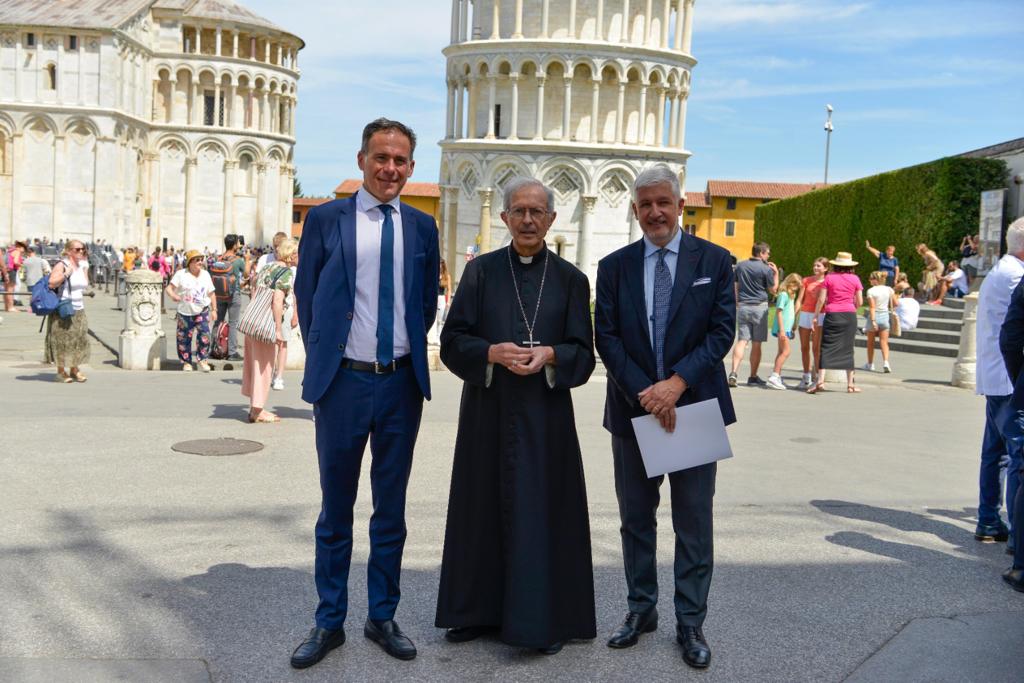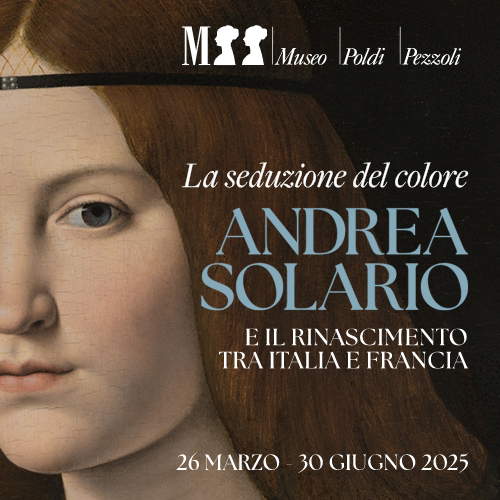Today is the Tower of Pisa's birthday! Here are all the events of the 850th anniversary
On August 9, 1173, the cornerstone of the Tower of Pisa was laid. Today, Aug. 9, 2023, more than eight centuries after work began on the world’s most famous bell tower, the tower celebrates its 850th birthday and is set to experience a year of events. Officially kicked off at 12 noon with the ringing of the tower’s bells, the year of celebrations, which will last until Aug. 9, 2024, opens today with the distribution of Poste Italiane postcards with the special 850th cancellation at the Museo delle Sinopie, with the evening opening, from 8:30 to midnight, of the monuments in Piazza del Duomo, with the illumination of the bell tower (and simultaneous projection of the 850th logo on the exterior wall of the Museo dell’Opera del Duomo) from 9:30, and with a piano concert by maestro Ramin Bahrami on the Cathedral’s graduations (with pieces by Bach, Beethoven, Rameau, Mozart, Brahms, Chopin, Rachmaninov, Mompou, Rohani) in front of the St. Rainier’s gate, an event open to all.
The celebrations, however, will not stop with today but will continue throughout the year with various initiatives. The minting of a commemorative medal commissioned from the State Mint and Mint was presented today: the medal, produced in two versions (one in silver with a circulation of 60 pieces and one in bronze with a circulation of 80 pieces), depicts on the “obverse” the depiction of the Leaning Tower of Pisa, on the left, the view of the apse of the Primatial Cathedral of Santa Maria Assunta (or Pisa Cathedral), on the right, the logo of the Opera della Primaziale Pisana (OPA), in the lap the inscription "CAMPANILE DELLA CATTEDRALE DI PISA 1173-2023, in the exergue the name of the author, medallist Uliana Pernazza, on the reverse the painting of the Madonna and Child known as the Madonna Sotto gli Organi, preserved in Pisa Cathedral, in the lap the inscription “Protege Virgo Pisas.” Then there will be an exhibition dedicated to the Tower of Pisa, with a Scientific Committee chaired by Professor Stefano Renzoni, which will be organized by the Opera della Primaziale Pisana starting in June 2024 in Piazza Duomo at the rooms of the former Opera Palace. The idea is to represent the Campanile through a narrative of works, images, restorations, prints, photographs, and television and film footage of the monument over the centuries, the primary intent of which will be to give clarity to the visitor that the Tower of Pisa is the Campanile of the Cathedral. Another exhibition, curated by Professor Alberto Tosi, will be organized at the Museo della Grafica and will propose studies on the ideal city and the value of the Campanile and the Piazza del Duomo of Pisa: the presence of a leading architect of international renown who will propose the aforementioned studies will provide an opportunity for his reading of the meaning and value of the Campanile and the entire Piazza del Duomo of Pisa. A third exhibition, curated by Gabriella Garzella and Chiara Bodei, set up at the University of Pisa, will cover the Malcov collection of objects related to the Tower of Pisa.
Space will then be given to a meeting in the Cathedral on the theme of “Science and Faith” (provisional title) with the presence of two important exponents one from the religious world and the other from the academic world, to a public initiative to explore thescientific/cultural importance of Cardinal Pietro Maffi in relation to Galileo Galilei, and to a Conference of European Cathedrals in November 2023 entitled The Balance between Conservation and Spirituality, to be organized by the Opera della Primaziale Pisana. Also, readings on the Campanile, by actors, of literary passages referring to the Bell Tower and Pisa Cathedral Square. In the musical event of Anima Mundi 2023, some musical moments with the presence of brass and percussion instruments are planned in the Campanile, before the concerts in the Cathedral on the 9th, 16th, 22nd and 28th. The Arsenale Cinema in Pisa will instead organize the initiative The Cinema and the Tower, with screenings of the films in which the Campanile appears. And then, in 2024, a press conference to present the state of health of the Campanile and the progress of monitoring activities (terrestrial and satellite) that will be organized by the Opera della Primaziale Pisana.
Then there will be calls for competitions, with different themes, with schools of all levels of Pisa and Province that will be activated with the Provveditorato agli Studi di Pisa, where the theme of the Campanile as a monument of recall to the sacred place will have to be addressed by young people. An unpublished chamber opera or symphonic piece dedicated to Pisa and the Campanile will also be performed, which will be organized by the Verdi Theater with the drafting of a special announcement.



“January 6, 1990 represented for Pisa a day of great sadness because of the necessary closure of the Campanile and, above all, a moment of great uncertainty about the solutions that were being considered to save the monument, whose risk of falling was now imminent,” Andrea Maestrelli, Operaio Presidente of the Opera della Primaziale Pisana, said this morning during his speech. "To our eyes, those moments now appear distant because of the time that has passed and because now daily, hundreds of tourists from all parts of the world climb the three hundred steps that lead from the base to the top of the belfry.
Even more distant and overcome anxieties about the very difficult and courageous choices experienced in years of intense study and work by the last International Committee for the Preservation of the Tower, the 17th, chaired by Professor Michele Jamiolkowski, who unfortunately left us last June 15 in the very year of the celebrations of the monument he bravely saved. For this courage, coupled with very high specific skills, it is appropriate once again to remember all the Members of the Committee even though unfortunately some of them are no longer with us, to whom the international community should address a due sign of great gratitude: Jean Barthelemy, Michele Cordaro, Michele D’Elia, Roberto Di Stefano, Salvatore Settis, Fernando Veniale, Remo Calzona, Giuseppe Creazza, Giorgio Croci, Giorgio Macchi, Luca Sanpaolesi, John Boscawen Burland, Eng. Michele Jamiolkowski, Carlo Viggiani, Francesco Guerrieri, Mario Desideri, Renato Lancellotta, Raymond Lemaire, Prof. Fritz Leonhardt, Gerald A. Leonards, Angela Maria Romanici, Alma Maria Minosi. This Committee, over the course of more than ten years, achieved a goal that seemed impossible to achieve and, by reducing the inclination of the Campanile by about 1900 arcseconds, corresponding to a decrease in the overhang of the seventh frame from the foundation plane by as much as 460 millimeters, restored the famous monument to its pre-existing condition dating back to the early nineteenth century. The gratitude and admiration of the entire scientific and cultural world for this achievement, and especially for the manner in which it was achieved, are to be attributed to the characteristics of an intervention that, despite the dramatic of the boundary conditions (the Campanile could have collapsed at any time and without any warning either due to subsidence of the underlying ground or to rupture of the structure in elevation), solved the problem without in the least modifying the characteristics of the monument, with absolute respect for its uniqueness and originality."
“The Opera della Primaziale Pisana,” Maestrelli continued, "witnesses and preserves in its archives numerous projects of all kinds, from the most authoritative to the most bizarre, which over the decades assumed anyway and constantly very heavy consolidation interventions that would have forever and irreversibly changed the soul of the very famous Monument: all this did not happen, and graphic synthesis as representative as ever of the technique adopted and the result achieved is that feather that in René Magritte’s painting The Enchanted Kingdom opposes the overhang of the Tower. As Professor Michele Jamiolkowski taught, the stabilization of the Tower was a real difficult challenge for geotechnical engineering due to the fact that interventions to the foundation soil could be dangerous, so the use of conventional technologies, such as injections or under-excavation posed an unacceptable risk. Instead, sub-excavation turned out to be a technique that was completely compatible with the requirements of a fully conservative architectural restoration and made it possible to overcome this incredible challenge. Today, restored to a stable condition, the Tower (or rather the Bell Tower of the Cathedral of Pisa), is still under control through a Surveillance Group, chaired by Professor Salvatore Settis and composed of Professor Carlo Viggiani and Professor Donato Sabia who has the delicate task of controlling its movements and whom I would like to thank for the work done with absolute dedication and professionalism. The rescue of the Campanile thus allows us to arrive serenely to today’s day that kicks off the celebrations of the 850th anniversary of the laying of the foundation stone (August 9, 1173) for the realization of the famous monument, with the intention of making the many initiatives planned, including the evening we are going to organize this evening, as inclusive as possible to allow everyone to feel involved. For this, I would like to thank H.E. the Archbishop of Pisa, the Mayor of Pisa, the Most Reverend Chapter of the Pisan Church, the Promoting Committee and the Scientific Committee moved by a common intent to celebrate our Campanile. I deliberately left for last, because we intend to give it the necessary prominence, the desire to dedicate, during the festivities, a celebratory moment in memory of Professor Michele Jamiolkowski by placing a plaque in his memory that will be placed in the Piazza del Duomo."
“The great successes achieved in the past,” concluded the Operaio President of the Primatial, “should not, however, suggest that the mission is accomplished. The project of the future is based on two words that are synergistic with each other: ’sustainability’ and ’welcoming.’ We want to look to the coming years thinking of a bell tower always lit with renewable and clean energy and above all accessible to all forms of disability. The beauties of the Square of Miracles must be accessible to everyone because they were designed and built for everyone. I thank you for your presence and with the Deputation and all the staff of the Opera della Primaziale Pisana I would like to wish a happy birthday to the Bell Tower that for a good 850 years never ceases to amaze us all and the whole world.”
 |
| Today is the Tower of Pisa's birthday! Here are all the events of the 850th anniversary |
Warning: the translation into English of the original Italian article was created using automatic tools. We undertake to review all articles, but we do not guarantee the total absence of inaccuracies in the translation due to the program. You can find the original by clicking on the ITA button. If you find any mistake,please contact us.



























